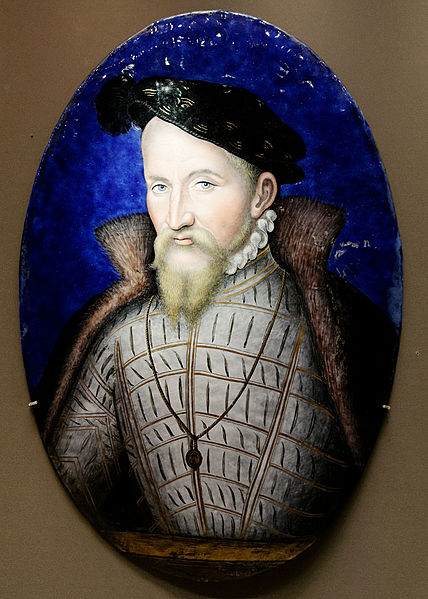FRANÇOIS DE LORRAINE
Second Duke of Guise, b. at the Château de Bar, 17 Feb., 1519, of Claude de Guise and Antoinette de Bourbon; d, 24 Feb, 1563. He was the warrior of the family, el gran capitan de Guysa, as the Spanish called him. A wound which he received at the siege of Boulogne (1545), won for him the surname Balafré (the Scarred). His defense of Metz against Charles V (1552) crowned his reputation. After a siege of two months the emperor was obliged to retire with a loss of 30,000 men. François de Lorraine fought valiantly at the battle of Renty (1554). The Truce of Vaucelles, signed in 1556 for a period of six years, followed by the abdication of Charles V, seemed about to end his military career.
The dukes of Guise, however, as descendants of the House of Anjou, had certain pretensions to the Kingdom of Naples, and it was doubtless with the secret intention of defending these claims that François de Lorraine furthered an alliance between Henry II and Pope Paul IV which was menaced by Philip II. In consequence of this alliance François de Guise entered Milanese territory (Jan., 1557), marched thence through Italy, and although neither the petty princes nor the pope gave him the assistance he expected, he took the little Neapolitan town of Campli (17 April, 1557), and on 24 April laid siege to Civitella. At the end of twenty-two days, being threatened at the same time by epidemic and the Duke of Alva, he fell back upon Rome, where he reorganized his army, and was preparing to return southward, when Henry II, after the victory of the Spaniards over the Constable de Montmorency at Saint-Quentin (23 Aug., 1557), summoned him to “restore France”.
 Guise returned to court (20 Oct., 1557) and was invested with the title of lieutenant-general of the kingdom. He captured the city of Calais (1-8 January, 1558) by taking into account the plans of attack drawn up by Coligny. In June he took Thionville, in July, Arlon. He was about to attack Luxemburg when he was halted by the peace of Cateau-Cambrésis (3 April, 1559), concluded by Henry II, despite the protests of the duke. Moreover, Henry was on the point of disgracing François de Guise, at the insistence of Diana of Poitiers and the Constable de Montmorency.
Guise returned to court (20 Oct., 1557) and was invested with the title of lieutenant-general of the kingdom. He captured the city of Calais (1-8 January, 1558) by taking into account the plans of attack drawn up by Coligny. In June he took Thionville, in July, Arlon. He was about to attack Luxemburg when he was halted by the peace of Cateau-Cambrésis (3 April, 1559), concluded by Henry II, despite the protests of the duke. Moreover, Henry was on the point of disgracing François de Guise, at the insistence of Diana of Poitiers and the Constable de Montmorency.
The accession of Francis II (10 July, 1559), however, and his consort, Mary Stuart, niece of François d Guise, was a triumph for the Guise family, and the Constable de Montmorency was disgraced. “François de Guise was supreme in the royal council. “My advice”, he would say, “is so-and-so; we must act thus.” Occasionally he signed public acts in the royal manner, with his baptismal name only. At the investigation of Antoine de Bourbon and the Prince de Condé, La Renaudie, a Protestant gentlemen of Périgord, organized a plot to seize the person of François de Guise and his brother, the second cardinal of Lorraine. The plot was discovered (conspiracy of Amboise, 1560) and violently suppressed. Condé was obliged to flee the court, and the power of the Guises was increased. The discourse which Coligny, leader of the Huguenots, pronounced against them in the Assembly of the notables at Fountainbleau (August, 1560), did not influence Francis II in the least, but resulted rather in the imprisonment of Condé. The king, however, died, 5 December, 1560-a year full of calamity for the Guises both in Scotland and France (see below, VI. Mary of Guise). Within a few months their influence waxed great and waned. After the accession of Charles, IX, François de Guise lived in retirement on his estates. The regent, Catharine de’ Medici, at first inclined to favour the Protestants, and to save the Catholic party, François de Guise formed with his old enemy, the Constable de Montmorency and the Maréchal de Saint-André the so-called triumvirate (April, 1561), hostile to the policy of concession which Catharine de’ Medici attempted to inaugurate in favour of the Protestants. The plan of the Triumvirate was to treat with Spain and the Holy See, and also to come to an understanding with the Lutheran princes of Germany to induce them to abandon the idea of relieving the French Protestants. About July, 1561, Guise wrote to this effect to the Duke of Würtemberg. The Colloquy of Poissy (September and October, 1561) between theologians of the two confessions was fruitless, and the conciliation policy of Catharine de’ Medici was defeated. From 15 to 18 February, 1562, Guise visited the Duke of Würtemberg at Saverne, and convinced him that if the conference at Poissy had failed, the fault was that of the Calvinists. As Guise passed through Vassay on his was to Paris (1 March, 1562), a massacre of Protestants took place. It is not known to what extent he was responsible for this, but it kindled the religious war. Rouen was retaken from the Protestants by Guise after a month’s siege (October); the battle of Dreux, at which Montmorency was taken prison and Saint-André slain, was in the end turned by Guise to the advantage of the Catholic cause (19 December), and Condé, leader of the Huguenots, taken prisoner. Guise was about to take Orléans from the Huguenots when (18 February, 1563) he was wounded by the Protestant Poltrot de Méré, and died six days later. “We cannot deny”, wrote the Protestant Coligny, in reference to his death, “the manifest miracles of God.”
At the suggestion of Henry II Guise has married in 1549 Anne d’Este (1531-1607), daughter of Hercule II d’Este, Duke of Ferrara, and of René of France, through her mother, granddaughter of Louis XII; she had been on the point of becoming the wife of Sigismund I, King of Poland. By her Guise had six sons and one daughter. Anne held the Admiral de Coligny responsible for the death of her husband, and her interview with the admiral at Moulins was only an apparent reconciliation. She soon married James of Savoy (d. 1583), by whom she had two children. She lived to see the extinction of the House of Este by the death of Alphonso II, fifth Duke of Ferrara, and to see two of her sons, Henry Duke of Guise, and the Cardinal of Guise (see below) slain at the château de Blois. “Oh great king”, she cried before the statue of her grandfather, Louis XII, “did you build this château that the children of your granddaughter might perish in it?” The poet Ronsard sang the praises of the wife of François de Guise, according to the fashion of the time:
Venus la sainte en ses grâces habite,
Tous les amours logent en ses regards;
Pour ce, a bon droit, telle dam mérite
D’avoir été femme de notre Mars.
GEORGES GOYAU (Catholic Encyclopedia)










